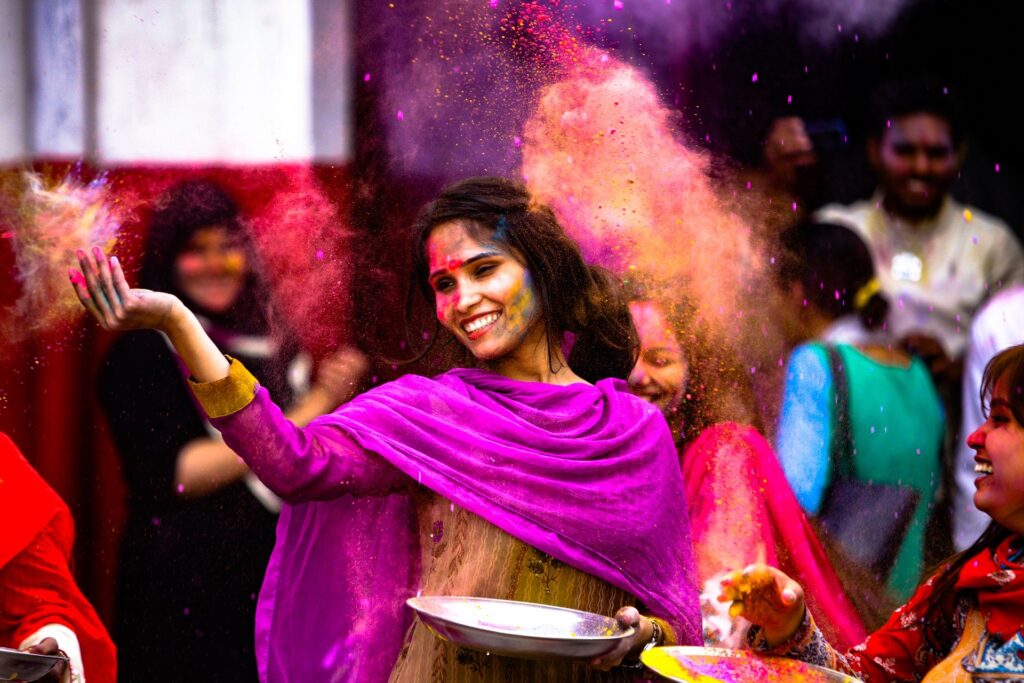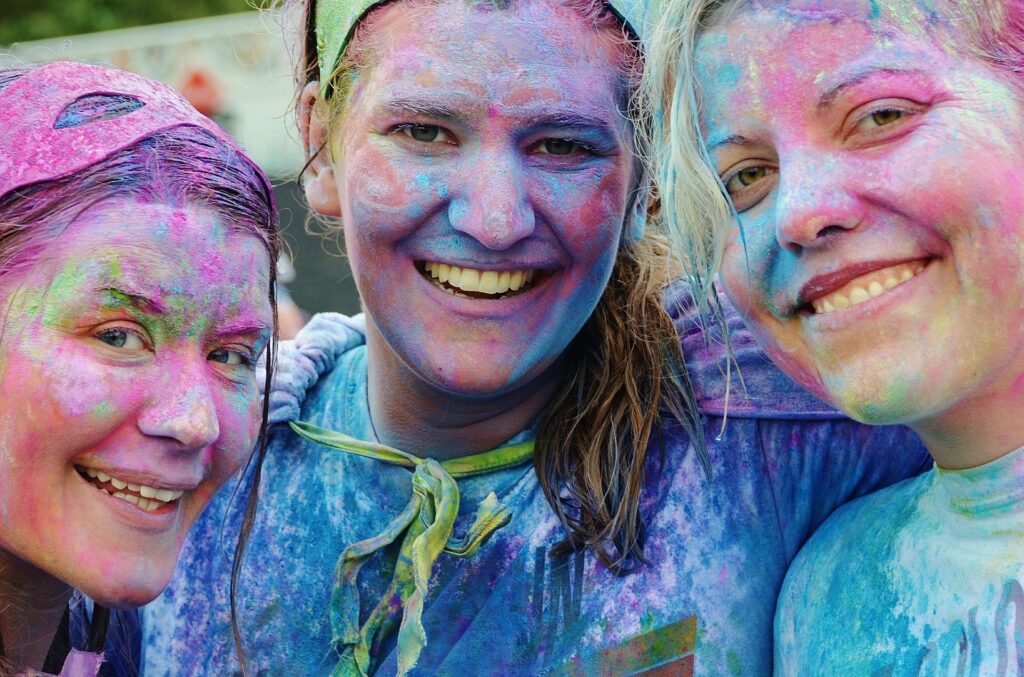In this essay we are going to talk about the Holi. Holi is a major Hindu festival that is celebrated with vigour and zeal throughout India and the rest of the subcontinent. Holi celebrations may range in customs and rituals from region to region in India, but they invariably entail joyful colour mixing. It’s a much-anticipated festival for both playful adventurers and foodies, not to mention youngsters.
Short Essay On Holi
The event, which takes place in the month of Phalgun, heralds the entrance of spring and the end of winter. According to the Gregorian calendar, the holiday occurs in late February or early March.
Holi- a colourful, joyous, and loving event
Holi differs from other Hindu celebrations in that it does not necessitate the adoration of any deity, as is the case with other Hindu festivals. The event encourages pure joy without any religious constraints.
Holi celebrations would be tough to imagine without colours. It’s also known as the “Festival of Colors.” People in the area play with coloured powders known as gulal. They splatter gulal on relatives and family members while hugging and wishing each other “Happy Holi.” Children were spotted in groups playing with various types of water guns (pichkari).
Click Here: Interesting Articles To Read When Bored
The houses and streets are all painted in a stunning and vivid blend of red, yellow, blue, orange, and violet. People don loose clothing and sprinkle each other with colours and coloured water now that the chilly winds of winter have passed. Everyone is painted in a variety of colours from head to toe, to the point where even one’s closest friend takes a moment or two to recognise.

The Holika Dahan Legend
Holi is a two-day Hindu festival that begins on the evening of the Hindu month of Phalgun’s full moon day (Purnima). The colour Holi is played in the morning of the second day.
The first day of Holi is known as Choti (Small) Holi, and in the evening, a Holika Dahan rite is performed. Bonfires are lit at street intersections or other suitable locations in the market, roads, streets, and colonies, among other places. People burn their old possessions in the fire to symbolise their feelings of jealousy, wrath, and resentment. The ceremony also represents good triumphing over evil.
One of the most popular Holika Dahan stories involves the demon king Hiranyakashyap and his son Prahlada. Prahlada was a devout follower of Lord Vishnu, which enraged Hiranyakashyap, who considered himself to be God after receiving the boon of immortality. His son Prahlada, on the other hand, was adamant about worshipping Vishnu and refused to worship his own father, Hiranyakashyap.
Read Also: Short Essay On Festivals
Hiranyakashyap became outraged after being rejected by his own son and began torturing Prahlada in order to urge him to relent. When Prahlada rejected on a frequent basis, Hiranyakashyap plotted with his sister Holika to dupe Prahlada into sitting with her over a blazing pyre. Holika was said to have a boon that protected her from being burned in a fire. Prahlada would be burned in the fire, while Holika would be protected by the boon.
Holika was finally able to persuade Prahlada to join her on the pyre. Prahlada accepted since he had a strong belief in his god Vishnu. Holika took a seat on the pyre, Prahlada in her lap. Despite the boon, Lord Vishnu intervened to save Prahlada as soon as the pyre was kindled, and Holika was burned to ashes. Holika’s boon didn’t function because she was only granted immortality if she entered a fire alone.
On Choti Holi, people burn pyres and it is done to commemorate the burning of the demon Holika as well as to welcome the colourful celebrations the next day.
Lath Mar Holi- Barsana
Lath Mar Holi has been celebrated for generations in the grounds of the Radha Rani temple in Barsana, a tiny hamlet near Mathura. Men from neighbouring Nandgaon travel to Barsana, where they are beaten with sticks known as lathis in Hindi. Men, on the other hand, would defend themselves with shields, and those captured would be forced to dance in women’s clothing.
Barsana’s LathMar Holi has become so popular that millions of native Indians and foreign tourists go to the city to see the festivities.
Play with Colors and Lose Your Inhibitions
Holi is a holiday that has a lot of good effects on people’s personalities and social relationships. It’s an event where you may get rid of your shyness and meet new people. What better way to meet new people than to have some fun with colours?
The festival will assist you in identifying the inner joy that has been suppressed within you. Get rid of your shyness, apprehension, and any other feelings that have been holding you back in your daily life. You can travel to a new world of colour, love, and joy with just a little effort on your part.
Spray colour on anybody you can without hesitation, and you’ll make new friends and remember the celebrations for a long time. All you have to do now is let go of your inhibitions and lighten your soul.
Festival in which it is the time to forgive and forget
Holi is a joyful festival. True joy is a soul-level experience rather than a physical one. We cannot be truly joyful if we are physically fit but harbour feelings of hatred or animosity against someone. Whether you have done something wrong to someone or someone has done something wrong to you, your inner joy suffers in both circumstances.
Holi is a wonderful opportunity to transform your hate into friendship or to mend a damaged connection. Let go of your rage and forgive the wrongdoer, or forgive yourself if someone or something has offended or saddened you. We shall be happy when we let go of all our negative emotions and open our arms to joy and a new world.
During the Holi season, it is customary to visit the homes of friends and relatives. Even after the Holi celebrations, the ritual continues for weeks. It is the ideal moment to mend broken connections or revive those that have been neglected.
Holi delicacies for the Platter
Holi is unquestionably a festival of colours, but it is also a festival of delights for those with a sweet tooth and a desire for other delectable dishes. Hundreds of delectable meals are created in various parts of India during the Holi festival. Every Indian area and culture has its own unique Holi delicacy.
The air is thick with a pleasant perfume and the essence of a variety of fried delicacies that are cooked in abundance in every home. One of my favourites is gujiya, a sweet treat popular in north India made by deep frying dough pockets filled with khoya (a type of milk meal) and nuts. Another Holi delicacy with northern Indian origins is Dahi Vada.
Puran Poli is a dish prepared during the Holi celebration in Maharashtra. It’s also a festive favourite in Maharashtra, and it’s served at practically every celebration. It’s essentially a flat dough chapati with delicious chana dal within.
Click Here: Articles To Read When Bored
‘Say no to Synthetic Colors’ during Holi
Because Holi is a celebration of colours, there were a number of pop-up shops offering cheap colours. Toxic metals such as copper, mercury, aluminium, and lead are frequently found in powdered colours. They may also contain toxic colours and pigments that are unfit for human consumption.
The use of low-cost synthetic colours causes a variety of problems, ranging from a minor rash to cancer. During the Holi festival, cases of skin lesions, burning sensations, and eye discomfort have been documented, probably due to the hazardous compounds in the colours. Synthetic colours are frequently made using a basis of maize starch or flour, which contaminates the environment further.

People are becoming more aware of the dangers of synthetic colours, which is a good thing. A widespread practise of employing organically derived colours is gaining traction. We save not only our health but also the health of the ecosystem by switching to colours generated from natural resources. Natural colours do not harm soil or water resources in the same way as manufactured colours can.
Natural colours are generated from natural, non-toxic minerals such as gulal, mehndi, and turmeric, among others. Flowers are also used to produce colours; for example, roses produce red, while sunflowers produce yellow. Furthermore, plants and flowers can be used to make a variety of natural colour dyes.
Conclusion
Holi is a festival with colour spread across everything and is celebrated with joy and merriment along with everyone. Prepare to be drenched in colour and water, but be careful not to hurt yourself or others. Be open minded and let go of your inhibitions, make new friends, console the ones who are dissatisfied, and mend broken connections. Be amusing while also being considerate of others. Don’t bother people unduly, and have calm behaviour at all times irrespective of the situation. Last but not least, this Holi, make a commitment to exclusively use natural colours so that there is no harm caused to you and your loved ones while simultaneously saving the environment.